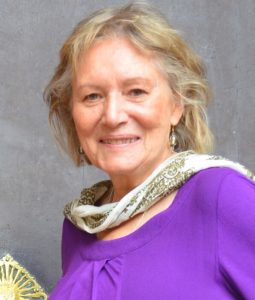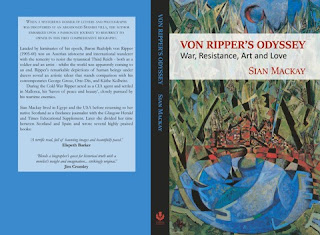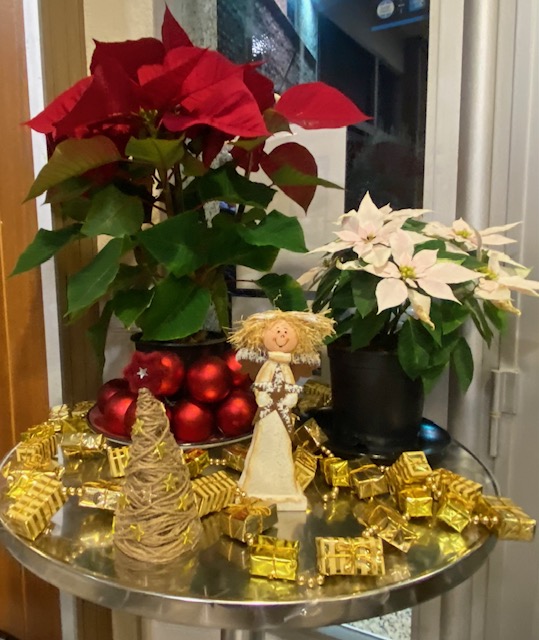Sian Mackay tells a story of War, Resistance, Art and Love in Von Ripper’s Odyssey
Published in the Majorca Daily Bulletin
Sunday 25th September 2016
by
Shirley Roberts
Sian Mackay is a writer and a long time resident of the Soller Valley. She has held many publishing roles including several years as a freelance journalist for newspapers including The Glasgow Herald and Times Educational Supplement. She also founded Moubray House Press in Edinburgh’s Royal Mile. Subsequently she has written literary journalism, narrative non-fiction and fiction, and divides her time between Scotland and the Soller Valley.
Sian held a book launch last Friday at the Gerhardt Braun Gallery in Palma. This was to promote her book Von Ripper’s Odyssey and return to the Von Ripper family the documents that sent her on an eight-year journey of discovery and fascination. As a working writer based in Majorca she was researching the lives of prominent Europeans who had been visitors or exiles to the Spanish island of Majorca: Georges Sand, Frederic Chopin, the Austrian Archduke Louis Salvador and Robert Graves were names on her list, and, as her friends knew she was always on the lookout for others. One day a telephone call alerted her to the existence of a blue file containing letters and photographs, found at an abandoned villa in Pollensa.
Sian’s friend explained that she had been searching in the Pollensa area for a villa on behalf of a Scottish artist who wanted to run summer painting schools on the island. When she came to Ca’n Cueg (The House of the Frogs) in Pollensa, she realised it would be perfect. The villa had been abandoned for several decades and would need reviving. Wandering in the garden, she came across the swimming pool, covered with slime from lack of use. A small changing pavilion stood beside it and she opened its door into a time warp.
Dinner suits and evening gowns from a bygone age hung from a rail, mildewed and frayed with age. She said she couldn’t believe her eyes and her sense that she had entered a fairy story increased when a large spider ran across the bench and disappeared under the hems of the dresses. It was as if the spider had arrived to draw her attention to the pile of warped books lying there and concealed among them, the blue file.
It had belonged to Baron and Baroness Rudolph ‘Rip’ von Ripper, who bought Ca’n Cueg in the early 1950s. He was an Austrian aristocrat and soldier/artist. Sian’s friend had photographed two Modernist-style murals painted by Ripper that suggested he had been far more than the lotus-eating socialite in some of the photographs. He was an accomplished artist.
The story haunted her, and as she would discover, the blue file was too slim to tell the whole story of this Austrian aristocrat’s life, but its contents hooked her in and she went on to track down further sources in Germany, Austria and the U.S.A. Month after month, year after year, the wonder grew as she pieced together von Ripper’s heroism in war and resistance, art and love. His eyewitness depictions of the concentration camp where he was tortured are particularly moving. Rudolph ‘Rip’ von Ripper (1905-1960) was a soldier as well as an artist, acclaimed in Europe and America for both these roles during the first half of the twentieth century. He became an American citizen in 1942 and joined the military as a war artist.
During the 1950s he strove to restore the reputation he had enjoyed as an artist before the Second World War, but the pressures of his work as a CIA agent and his need to earn money to keep his socialite wife in grand style told against his ambition, and his early masterpieces became forgotten by history.
The story of Von Ripper is available now and is the sort of read that blends fact into more fact making it an almost unbelievable story. There are many part of this relatively short life that could be pulled out for special attention but the one that has taken my imagination is to do with his later years living in Pollensa. This was a man who had been a Resistance Fighter and a defender of the the Jewish people in the war. This had earned him spells in prison and the attention of the notorious Otto Skorzeny who was Hitler’s favourite Commando and known as the third Reich’s Scarlet Pimpernel. In spells of awful brutality at the hands of this man Von Ripper was told that no matter what happened in his life and how the war might end that the the long arm of Fascism would reach out and get him, no matter where he lived or what he was doing. At the time the threat was awful but the human spirit is strong and Rudolph Von Ripper went on to paint, to work, to love and to enjoy the life that he and his socialite wife created in the glitterati world of the Pollensa painters and intellectuals of the time. His house was a magnet for glorious parties and meetings of the international world of the intellectuals of Majorca. Memories of the limousines carrying the great and the good in their evening gowns and furs still exist to this day. Local Majorcan children, now grandparents, still talk about that era and the culture shock it was to their families.
In amongst this life the most bizarre news began to break and that was in the shape of a new home owner who had purchased a house by the sea just two miles from the Von Ripper residence. Mr Otto Skorzeny had been denazified by the party and was free to travel to any European country that would accept him. He moved to Majorca and centered his life in Alcudia. Rumours began to circulate as soon as he arrived that he was creating the Alcudia Rat Line and facilitating the movement of wanted Nazis via Alcudia on to boats that were waiting to take them on to South America. Rat Lines were being created in many places in Europe and in Skorzenys case Alcudia was not his only one. In 1959 he bought a house in County Kildare in Ireland and it is said that he used this a base to move 200 – 300 war criminals through the Irish countryside en route to the Americas. Ireland was never totally comfortable with his presence there and eventually he relocated to Madrid where he spent the rest of his life.
Meanwhile back in Pollensa in the late 1950’s the nightmare of having Skorzeny as a near neighbour with everything evil he stood for in Von Ripper’s life was a burden too far. In 1960 Rudolph Von Ripper was found dead in mysterious circumstances in Ca’n Cueg. His fast paced, eventful life over at the age of 55 years. Coincidence or what that his near neighbour told him that he would never escape from the clutches of the Nazi’s who could never forgive him for his resistance to their cause. As an Austrian they expected him to be one of them but that was never going to be the case.
Sian’s eight years of travels looking at this life and his art in all the places he practiced them have convinced her that this talent must be recognized. It is her ambition from the publishing of this book and the telling of the story to a wider audience that his art might be exhibited here in Majorca where his inspiration came from.
Von Ripper’s Odyssey is available now on Amazon and in all good bookshops. It is also available on Kindle.
The Von Ripper family who attended the book launch were presented with the blue file full of documents that has told the world this amazing story. The papers are back with their rightful owners who are proud that their family has been recognized for the fine resistance work they achieved in the war.
Sian’s eight-year investigation and development of this story will stay with her. The Von Ripper story has influenced her mind and her understanding of the war years. It is going to be hard to let it go now that the fine job has been done.
· The Von Ripper story should be a film one day it has all the ingredients for success. In the meantime, let’s content ourselves with this fine book created by Sian Mackay which is a great true story.
.










